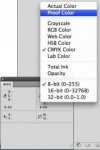I find using selective colour works well in your scenario. It may require a crude selection area or a precise one depending on the image components. Or a combination of selective colour and curves and yes, I prefer working in CMYK in part because of my long time experience with CMYK, (I am considered by some, a dino). Key is to save as each revision level so you can return to any round as the customer's whim dictates.
Either removing colour, say minus cyan (lightens) or adding the opposite colours, in this case, magenta, yellow (darkens); the judicious use of black can also be the saviour. As I work a lot with folding carton cardboard, GCR as an approach which voids a channel or nearly voids a channel is also powerful. Dark blues and or purples are best void of yellow when printing on recycled board, as are magenta in greens or cyan in reds, hence GCR the image.
My two cents worth,
J














